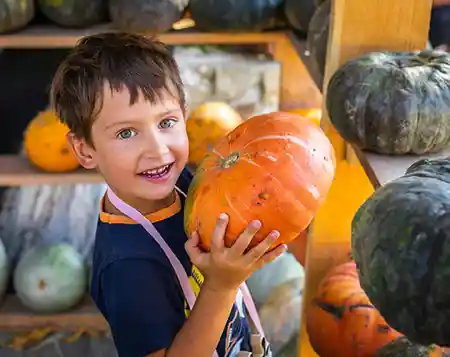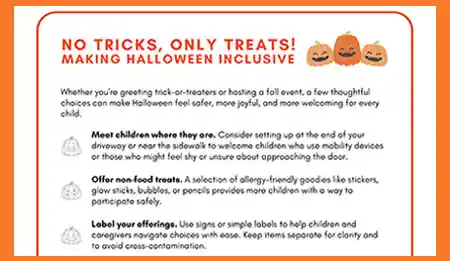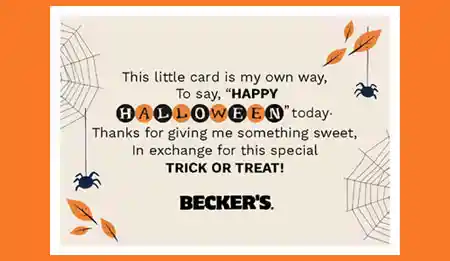Inclusive Approaches to Halloween

Thoughtful Seasonal Traditions:
Inclusive Approaches to Halloween
October brings pumpkins on porches, costumes in classrooms, and candy everywhere you turn. For many children, Halloween is a highlight of the season. But for others, it can feel overwhelming, isolating, or even off-limits.
Not every program or family celebrates Halloween. Some may choose not to participate due to cultural or religious beliefs. Others may want to join in but face barriers: costumes can be expensive, food can be tricky, and sensory needs can make some activities hard to enjoy. If your school community does choose to celebrate, consider how collaboration with families can shape a more inclusive approach. When we open conversations early and ask families about their preferences, boundaries, and hopes, we build shared understanding and trust. This kind of thoughtful planning lays the foundation for celebrations where everyone can participate in ways that feel safe, meaningful, and joyful.
Costumes, Comfort, and Creative Alternatives
Costume parades can be joyful, but they can also highlight inequities. Not every family has the resources to buy or make a costume, and some children are uncomfortable dressing up due to sensory or personal reasons.
Consider:
- • Offering alternatives like “hat day” or “favorite color day.”
- • Encouraging costumes made from classroom props (scarves, capes, masks children decorate themselves).
- • Remove the dress-up stress by allowing children to try on costume pieces in advance.
Offer flexibility in how children participate; let comfort lead the way. Make sure families know that participation is optional and that flexibility is welcomed and supported. It can be helpful to re-orient to the purpose of community celebrations. The goal isn’t the outfit; it’s giving children a safe, playful way to express themselves.
Candy, Food, and Allergy Awareness
Halloween often revolves around sweets, but food allergies, dietary restrictions, and family choices can make that tricky. Think beyond candy:
- • Offer candy alternatives such as stickers, pencils, or small toys.
- • Incorporate festive elements that don’t involve food, like themed songs, stories, games, or crafts.
- • If you do include snacks, check labels carefully, offer allergy-friendly choices, and communicate clearly with families.
When food isn’t the centerpiece, there’s more room for every child to engage comfortably and safely.
Cultural and Family Considerations
For children whose families don’t celebrate Halloween, inclusion means creating space without pressure or judgment. A responsive approach might include:
- • Framing activities around broader fall themes (pumpkins, harvest, animals at night).
- • Offering parallel activities so no child feels spotlighted for opting out.
- • Asking families whether and how they observe the season and honoring those insights in your planning.
This small step sends a big message: we respect all families’ values.
Supporting Sensory Needs
For some children, Halloween brings more sensory overload than seasonal joy. Costumes may feel scratchy or constricting. Loud music, crowded classrooms, and unpredictable routines can trigger discomfort or dysregulation.
Consider:
- • Offering a quiet corner during parties and large-group events.
- • Providing fidget tools, noise-reducing headphones, or sunglasses for children who need them.
- • Previewing the day’s changes visually with photos, stories, or now/next boards.
Thoughtful, sensory-aware planning helps reduce stress and opens up a more inclusive range of entry points for engagement.
Building Community Traditions
Inclusion isn’t about one day. It’s about building traditions that honor every child’s strengths and stories. Seasonal activities can help connect children to the time of year in ways that are sensory-rich and culturally responsive.
If you're in a region without a lot of trees with changing colors, consider other seasonal markers that are relevant in your area. Pumpkins and apples, for example, can spark sensory-rich learning through baking, science experiments, and creative art experiences like stamping or painting.
- • A neighborhood walk to notice fall changes.
- • A classroom gratitude tree that grows through the season.
- • Storytelling or dramatic play focused on light and shadow, change, or imagination.
These anchor points keep the season playful and meaningful, without leaving anyone out.
Every classroom is different, because every community is different
Sometimes what seems like “just fun” can unintentionally exclude. A thoughtful lens helps us notice where children might be left out: whether that’s a child who doesn’t have a costume, one who can’t eat the candy, or one who feels overwhelmed by the noise and unpredictability.
The most inclusive Halloween celebrations are co-created with the children and families you serve. When we listen closely, plan collaboratively, and lead with empathy, we create traditions that reflect the strengths, stories, and spirit of our classroom communities. Through this process, we don’t lose the magic of Halloween. We gain something richer: a community where every child can find their place in the fun.
Infographic: Considerations for an inclusive Halloween
This quick guide offers families, educators, and community members simple and thoughtful tips to help make Halloween more inclusive, welcoming, and fun for everyone.
Printable: Inclusive Trick-or-Treat Cards
Whether it's saying, “Trick or Treat!” or “Thank you,” these cards can help non-speaking or minimally verbal children join in and feel included, no words needed! Share with families to support all children’s participation in the reciprocity routine of trick-or-treating.

Christine Murray is an Early Childhood Education Specialist with Becker’s Education Team.
As an educator, coach and leader, Christine is inspired by the curiosity, joy and wonder that children so generously model for us. She earned her M.A. in Innovative Early Childhood Education at the University of Colorado Denver and loves collaborating with and supporting others in the field. Grounded in relationships and guided by empathy, Christine is always learning, connecting and creating.


